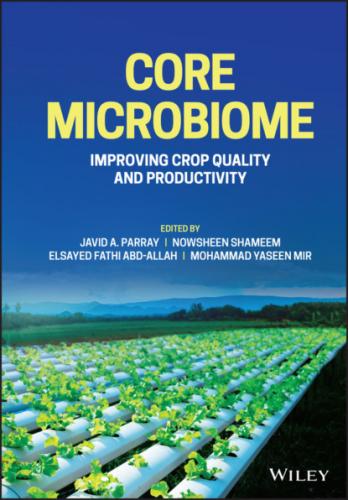3.4 Microbe-Mediated Mitigation of Abiotic Stresses
Crop plants need to manage external environment pressure exerted by edaphic factors with intrinsic biological mechanisms, as a result of which growth, development, and productivity fail. Microorganisms are the natural populations of complex environments that have various metabolic abilities to mitigate abiotic stresses. Plant–microbe interaction comprises a complex mechanism within the plant cellular system that modulates local and systemic mechanisms in plants to offer defense under adverse conditions (Meena et al. 2017). Many microbes have genetic and metabolic abilities to mitigate abiotic stresses in plants (Gopalakrishnan et al. 2015). The most important rhizosphere inhabitants comprise Pseudomonas (Sorty et al. 2016), Azotobacter (Sahoo et al. 2014), Pantoea (Sorty et al. 2016), Enterobacter (Nadeem et al. 2014), Burkholderia (Ait Barka et al. 2006), Trichoderma (Ahmad et al. 2015), and cyanobacteria (Singh et al. 2005), which have been used for plant growth to alleviate multiple abiotic stresses.
A sequence of plant-protective mechanisms was acquired during evolution to combat adverse environmental situations (Yolcu et al. 2012). These processes cause re-programming in the cells to enable repetitive bio-physico-chemical processes regardless of the external situation. Most of the time, plants tend to decrease the burden of environmental stresses with the help of the microbiome residing in the soil (Ngumbi and Kloepper 2016). The application of phytohormones supplementation has been reported to improve plant growth and development as well as metabolic activity under stressful conditions. Root microbes are very important for managing target metabolism and induced host tolerance against abiotic stress in medicinal plants (Egamberdieva et al. 2017).
In addition to the stress-tolerant microorganism’s application selection, screening might be a good option to overcome stress limitation in crop plants. Indian mustard (Brassica juncea) oil contents were improved in NaCl-affected soil by Trichoderma harzianum application. It improves essential nutrients, triggers antioxidants accumulation and osmolytes while decreases Na+ uptake (Ahmad et al. 2015). Pseudomonas sp. and Acinetobacter sp were reported to enhance the production of indole acetic acid (IAA) and 1-aminocyclopropane-1-carboxylic acid deaminase (ACC) in barley and oats in salt-affected soil.
3.5 Plant Root Exudates and the Recruitment of Beneficial Microbes
Root exudates serve as indicators that start the symbiotic relation between arbuscular mycorrhizal fungi and rhizobia. Root exudates contain ions such as oxygen, water, an inorganic acid, and (H+) but mainly consist of carbon compounds (Bais et al. 2004). Lower-weight organic compounds (amino acid, organic acid, phenols, sugars, secondary metabolites) and high-weight organic compounds (proteins, polysaccharides) are present in the soil (Badri et al. 2009). Microorganisms established a sensory system called chemotaxis, which guides these components secreted from roots to deliver essential nutrition and energy for survival under stressful conditions. Moreover, Gao et al. (2011) observed that plants might enhance the degradation by the exudation of enzymes, such as phenol oxidase, laccase, and peroxidase through the root. As a result, the oxidation of various hydrocarbons degrades them into intermediate products. The combined application of arbuscular mycorrhizal fungi and septate endophyte was studied in 36 medicinal plant species. The level of abundance of arbuscular mycorrhizal fungi in the roots varied from 2.5% (Helianthus tuberosus) to 77.9% (Convallaria majalis) (Zubek and Błaszkowski 2009).
3.5.1 Multi-omics Approaches Used to Mitigate Abiotic Stresses in Medicinal Plants
Multi-omics approaches would help in dissecting the mechanism of combating stress by these plant–microbe interactions (Dubey et al. 2020). Plant–microbe interaction improves metabolic activity and resistance against stresses (Nguyen et al. 1997). For this purpose, molecular, biochemical, and physiological aspects are important to understand complex processes. At the same time, we need to determine the process of stress mitigation in medicinal plants for higher productivity (Meena et al. 2017). Stress alleviation is an important and challenging issue and gets results by altering crop genetics and it requires extensive breeding efforts (Grainger and Rajcan 2014). Low genetic diversity and temperature fluctuation make breeding efforts more challenging (Manavalan et al. 2009). Molecular marker breeding is effective to speed up tolerance in cultivars. For this purpose, the availability of molecular markers that are tightly linked with genomic loci that are responsible for tolerance is important for selection. With the new advancement of DNA sequencing and metabolic profiling technology, a new era of phytochemical genomics has emerged. In this new technology, the biosynthetic mechanism, regulation, function, and evolution of phytochemicals are determined by the integration of genomics and omics technology, such as metabolomics, proteomics, and transcriptomics (Saito 2013). Endophytic actinomycetes are the source of producing natural products with antifungal activity (Passari et al. 2015). Transcriptome data of Catharanthus roseus recognized genes involved in monoterpenoid indole alkaloid biosynthesis. Furthermore, these gene products have been established to be cytochrome P450 hydroxylating aspidosperma alkaloids at 19 positions (Giddings et al. 2011) and iridoid synthase reductively converting 10-oxogeranial scaffold (Geu-Flores et al. 2012). Morphine biosynthesis genes are identified by the omics technique in opium poppy (Papaver somniferum) (Hagel and Facchini 2010. Multi-omics approaches such as genomics, transcriptomic, proteomics, metabolic pathway, and phenomics integrative studies are compulsory to study plant and microbes and their interaction with environment, and generated data could be helpful in mitigating abiotic stresses. It will also be helpful to report microbial groups for their proper working and functions in the soil.
3.5.1.1 Genomics
An analytical database (http://metnetdb.org/mpmr_public/) regarding transcriptome and metabolic data for 14 medicinal plants are available for gene function. In this way, the possible microbial production of glycyrrhetinic acid was recorded. Yamazaki et al. (2013) reported the differential transcriptome analysis along with metabolic profiling, and identified candidate’s genes involved in the biosynthesis pathway of alkaloids and anthraquinones. Transcriptomics of glandular trichomes,
